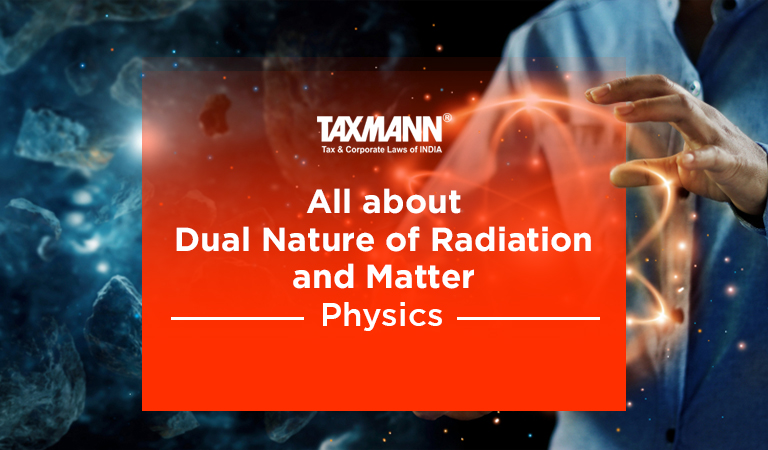All about Dual Nature of Radiation and Matter | Physics
- Other Laws|Blog|
- 4 Min Read
- By Taxmann
- |
- Last Updated on 22 September, 2022
Table of Contents
2. Einstein Photoelectric Relation
Checkout Tan Print's Physics for NTA CUET (UG) 2022 which intends to cater to the principal needs of all the students preparing for the Common University Entrance Test (CUET) at the Undergraduate Level in the Physics Domain. This book contains the practice material in a highly student-friendly and thorough manner.
1. A Quick Review
-
- Energy of photon of frequency (n) or wavelength (l)
E = hv = (eV – A)
-
- Momentum of photon P =
- Effective mass of photon
- Momentum of photon P =
Note: Net mass of photon is zero
-
- Intensity of light =
- Radiation force
- Intensity of light =
(1) Surface is perfectly reflecting
Fradiation =
(2) Surface is perfectly absorbing
Fradiation =
-
- The phenomenon of ejection of electron due to absorption of photon of suitable frequency is known as photo electric effect.
- The minimum energy of photon require to just eject electron from metal surface is known as work function of metal.
- The frequency of photon corresponding to work function of metal is known as threshold frequency.
- The phenomenon of ejection of electron due to absorption of photon of suitable frequency is known as photo electric effect.
-
- v threshold =
- The wavelength of photon corresponding to work function of metal is known as threshold wavelength.
- y threshold =
- In photoelectric effect one photon interact with only one electron.
- v threshold =
2. Einstein Photoelectric Relation
-
- Kinetic energy of ejected electron = Energy of photon – work function.
-
- If we increase the frequency (or decrease the wavelength) of photon. The energy of photon will increase and hence energy of ejected electron will increase.
- If we increase intensity of photon (i.e. No. of photon falling on unit area in unit time) then No. of ejected electron will increase and hence photo current will increase.
- The magnitude of minimum potential to just stop the flow of photo current is known as cut-off potential. It depend on frequency or wavelength of incident photon.
-
- If we increase the intensity of photon, saturation current will increase but cut-off potential (stopping potential) will remain same.
-
- If we increase the frequency (decrease the wavelength of photon, cut-off potential (stopping potential) will increase but saturation current will remain same.
- De-Broglie hypothesis of matter wave states that wave nature can also be associated with microscopic particle.
- Wavelength of matter wave
- For Charged particle (E) = qV
- For non-relativistic motion P =
So,
Where,
h = plank constant
m = mass of particle
E = Kinetic energy of particle
q=charge on particle
V=potential difference across which charged particle is moved
-
- For electron moved across V-volt potential
- Davisson Germer experiment show wave particle duality.
- For electron moved across V-volt potential
Disclaimer: The content/information published on the website is only for general information of the user and shall not be construed as legal advice. While the Taxmann has exercised reasonable efforts to ensure the veracity of information/content published, Taxmann shall be under no liability in any manner whatsoever for incorrect information, if any.

Taxmann Publications has a dedicated in-house Research & Editorial Team. This team consists of a team of Chartered Accountants, Company Secretaries, and Lawyers. This team works under the guidance and supervision of editor-in-chief Mr Rakesh Bhargava.
The Research and Editorial Team is responsible for developing reliable and accurate content for the readers. The team follows the six-sigma approach to achieve the benchmark of zero error in its publications and research platforms. The team ensures that the following publication guidelines are thoroughly followed while developing the content:
- The statutory material is obtained only from the authorized and reliable sources
- All the latest developments in the judicial and legislative fields are covered
- Prepare the analytical write-ups on current, controversial, and important issues to help the readers to understand the concept and its implications
- Every content published by Taxmann is complete, accurate and lucid
- All evidence-based statements are supported with proper reference to Section, Circular No., Notification No. or citations
- The golden rules of grammar, style and consistency are thoroughly followed
- Font and size that’s easy to read and remain consistent across all imprint and digital publications are applied
















 CA | CS | CMA
CA | CS | CMA


